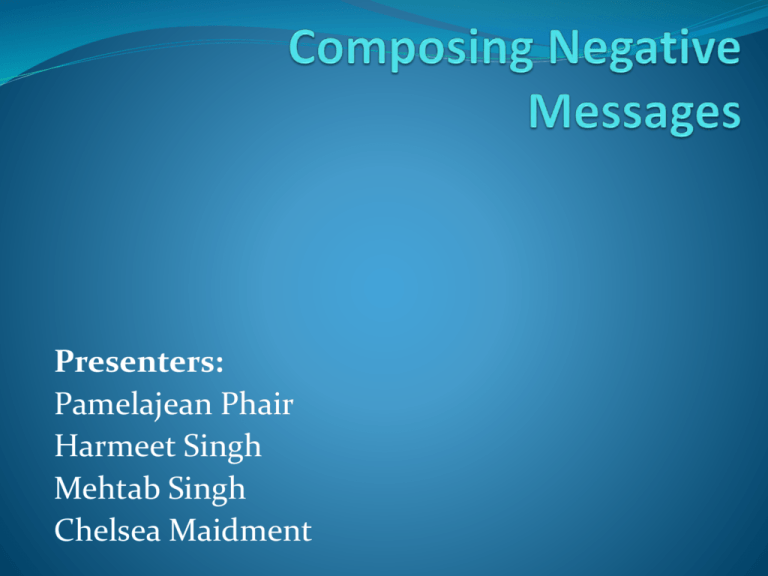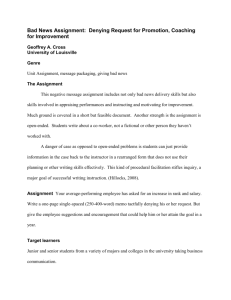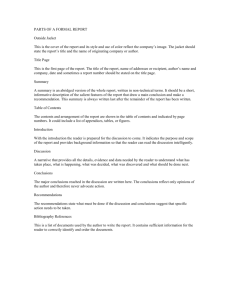Composing Negative Messages - Mehtab Singh's E
advertisement

Presenters: Pamelajean Phair Harmeet Singh Mehtab Singh Chelsea Maidment Composing Negative Messages Organizing Negative Messages Writing Negative Messages to Superiors Writing Negative Messages to Peers & Subordinates Reasons for Refusals Incorporating PAIBOC in Negative Messages Organization of Negative Messages 1. Begin with a buffer or a neutral statement Explain your refusal 3. State the negative message once, make it clear 4. End with a positive and optimistic statement 2. Whenever writing a negative message always begin with a buffer or a neutral statement Preparation statement Something agreed upon, or a thank you Serving harmony Buffer serving a purpose Introduce the refusal by explanation Prepares the reader to accept refusal Clear and convincing reasons Avoid saying there is nothing you can do Omit any weak reasoning, keep reasons to a few strong ones State the refusal Clearly and directly Exclude reasoning from the refusal statement, keep the two separate Never put refusal in a paragraph of its own Must ensure refusal is absolutely clear Sometime you may be able to imply the refusal Present an alternative or compromise Doing so shows empathy and proves you care to help solve the readers problems This allows the reader to still get what they want Presents yourself and organization positively, helps build goodwill Allow the reader to have the freedom back that was taken away from the refusal originally End positively Save a very good alternative to the end of the refusal The ending should “look to the future” Avoid any statements that are cliched or not in the favour of the reader Details about the buffer The buffer allows that writer to delay the negative message Buffers are a good idea if you know the reader is wanting a common agreement The buffer should not be positive nor negative; the reader should not be mislead about the refusal Examples, good news, references to enclosures, etc . Using a buffer appropriately Omit the buffer when: If the reader prefers bottom line messages such as a CEO or corporate director o If the reader is suspiciously or extremely angry o If the reader will not take no for an answer o If the reader might ignore a letter with a neutral or bland first paragraph o Giving Bad News to Superiors Describe the Problem Tell how it happened Describing the options for fixing it Recommend a solution and ask for action Giving Bad News to Peers and Subordinates Describe the Problem Present an alternative, if one is available If possible, ask for input or action communication is crucial. The reader’s reaction is influenced by the answers to these questions: Do you and the reader have a good relationship? Does the organization treat people well? Have readers been warned of possible negatives? Have readers “bought into” the criteria for the decision? Do communications following the negative build goodwill? Reasons for Refusing Make the reason for refusal clear and convincing in terms of audience’s needs and wants. Always give better reason rather than giving a weak one. Avoid saying that you cannot do something. If you have several reasons for saying no, use only those that are strong and watertight. Organizing Negative Letters to Customers Provide a buffer, if possible. Give the reason for the refusal before the refusal itself when you have a reason that readers will understand and accept. Give the negative just once, clearly. Present an alternative or compromise, if one is available. End with a positive, forwarding- looking statement . Refusals There are two types of refusals. 1. Direct Refusals: you cannot get insurance for just one month. 2. Implied Refusal: The shortest term for an insurance policy is six months. Alternatives It offers the reader another way to get what he or she wants. It also suggest that you really care about the reader and about meeting his or her needs. It enables the reader to re-establish the psychological freedom you limited when you said no. It allows you to end on a positive note and this to present yourself and your organization as positive , friendly, and helpful. How to do Endings ? If you are a goal alternative organisation then in the end give offer and discount to the customer. The best ending look to the future. If you want to maintain goodwill and retain positive business relationships then, End Sincerely. Avoid endings that seen insincere or clichéd. Incorporating PAIBOC in Negative Messages Purpose Audience Information Benefits Objections Context Purpose What is the purpose of the message being communicated? Audience Who is the message being communicated to? What are the characteristics of the audience? Information What information must your message include? Benefits What reasons or benefits can be included to positively support the message? Objective What objections can you expect the recipient of the message to have? Should you de-emphasize any elements of your message? Context How will the context effect the recipients response? What is your relationship with the recipient? Maslow's Hierarchy Checklist for Negative Messages





